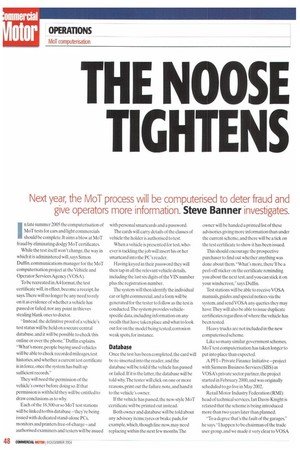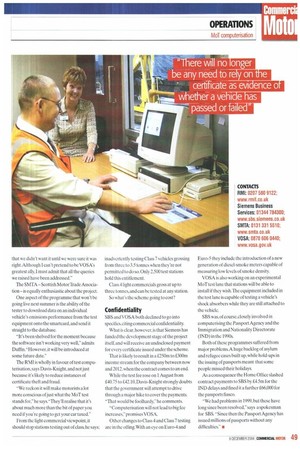THE NOOSE TIGHTENS
Page 50

Page 51

If you've noticed an error in this article please click here to report it so we can fix it.
Next year, the MoT process will be computerised to deter fraud and give operators more information. Steve Banner investigates.
In late summer 2005 the computerisation of MoT tests for cars and light commercials should be complete. It aims a blow at MoT fraud by eliminating dodgy MoT certificates.
While the test itself won't change, the way in which it is administered will, says Simon Duffin,communications manager for the MoT computerisation project at the Vehicle and Operator Services Agency (VOSA).
To be recreated inA4 format, the test certificate will , in effect, become a receipt, he says.There will no longer be any need to rely on it as evidence of whether a vehicle has passed or failed, nor any point in thieves stealing blank ones to doctor.
"Instead, the definitive proof of a vehicle's test status will be held on a secure central database, and it will be possible to check this online or over the phone," Duffin explains. "What's more.people buying used vehicles will be able to check recorded mileages, test histories, and whether a current test certificate is in force, once the system has built up sufficient records."
They will need the permission of the vehicle's owner before doing so. If that permission is withheld they will be entitled to draw conclusions as to why.
Each of the 18,500 or so MoT test stations will be linked to this database — they're being issued with dedicated stand-alone PCs, monitors and printers free-of-charge — and authorised examiners and testers will be issued with personal smartcards and a password.
The cards will carry details of the classes of vehicle the holder is authorised to test.
When a vehicle is presented for test, whoever is tackling the job will insert his or her smartcard into the PC's reader.
Having keyed in their password they will then tap in all the relevant vehicle details, including the last six digits of the VIN number plus the registration number.
The system will then identify the individual car or light commercial, and a form will be generated for the tester to follow as the test is conducted.The system provides vehiclespecific data, including information on any recalls that have taken place and what to look out for on the model being tested;corrosion weak spots, for instance.
Database
Once the test has been completed, the card will be re-inserted into the reader, and the database will be told if the vehicle has passed or failed. If it is the latter, the database will be told why The tester will click on one or more reasons, print out the failure note, and hand it to the vehicle's owner.
If the vehicle has passed, the new-style MoT certificate will be printed out instead.
Both owner and database will be told about any advisory items; tyres or brake pads, for example, which, though fine now. may need replacing within the next few months.The owner will be handed a printed list of these advisories giving more information than under the current scheme, and there will be a tick on the test certificate to show it has been issued.
This should encourage the prospective purchaser to find out whether anything was done about them. "What's more, there'll be a peel-off sticker on the certificate reminding you about the next test, and you can stick it on your windscreen," says Duffin.
Test stations will be able to receive VOSA manuals, guides and special notices via the system. and send VOSA any queries they may have. They will also be able to issue duplicate certificates regardless of where the vehicle has been tested.
Heavy trucks are not included in the new computerised scheme.
Like so many similar government schemes, MoT test computerisation has taken longer to put into place than expected.
A PFI — Private Finance Initiative — project with Siemens Business Services (SBS) as VOSA's private sector partner, the project started in February 2000, and was originally scheduled to go live in May 2002.
Retail Motor Industry Federation (RMI) head of technical services. Ian Davis-Knight is relaxed that the scheme is being introduced more than two years later than planned.
"To a degree that's the fault of the garages," he says."I happen to be chairman of the trade user group, and we made it very clear toVOSA that we didn't want it until we were sure it was right.Although I can't pretend to be VOSA's greatest ally,' must admit that all the queries we raised have been addressed.
The SMTA — Scottish Motor Trade Association —is equally enthusiastic about the project.
One aspect of the programme that won't be going live next summer is the ability of the tester to download data on an individual vehicle's emissions performance from the test equipment onto the smartcard, and send it straight to the database.
"It's been shelved for the moment because the software isn't working very well," admits Duffin."However, it will be introduced at some future date."
The RMI is wholly in favour of test computerisation,says Davis-Knight, and notjust because its likely to reduce instances of certificate theft and fraud.
"We reckon it will make motorists a lot more conscious of just what the MoT test stands for," he says. "They'll realise that it's about much more than the bit of paper you need if you're going to get your car taxed."
From the light commercial viewpoint,it should stop stations testing out of class, he says; inadvertently testing Class 7 vehicles grossing from three to 3.5 tonnes when they're not permitted to do so. Only 2,500 test stations hold this entitlement.
Class 4 light commercials gross at up to three tonnes, and can be tested at any station. So what's the scheme going to cost?
Confidentiality
SBS and VOSA both declined to go into specifics. citing commercial confidentiality.
What is clear, however, is that Siemens has funded the development stage of the project itself, and will receive an undisclosed payment for every certificate issued under the scheme.
That is likely to result in a £250m to £300m income stream for the company between now and 2012, when the contract comes to an end.
While the test fee rose on 1 August from £40,75 to €42.10, Davis-Knight strongly doubts that the government will attempt to drive through a major hike to cover the payments. "That would be foolhardy," he comments.
"Computerisation will not lead to big fee increases," promises VOSA.
Other changes to Class 4 and Class 7 testing are in the offing. With an eye on Euro-4 and Euro-S they include the introduction of a new generation of diesel-smoke meters capable of measuring low levels of smoke density.
VOSA is also working on an experimental MoT test lane that stations will be able to install if they wish.The equipment included in the test lane is capable of testing a vehicle's shock absorbers while they are still attached to the vehicle.
SBS was, of course, closely involved in computerising the Passport Agency and the Immigration and Nationality Directorate (IND) in the 1990s.
Both of these programmes suffered from major problems.A huge backlog of asylum and refugee cases built up, while hold-ups in the issuing of passports meant that some people missed their holidays.
As a consequence the Home Office slashed contract payments to SBS by £4.5m for the IND delays and fined it a further £66,000 for the passports fiasco.
"We had problems in 1999, but these have long since been resolved," says a spokesman for SBS. "Since then the Passport Agency has issued millions of passports without any difficulties." •


























































































































































































